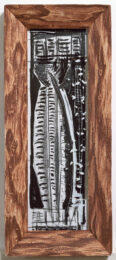

Born in Ohio in 1941, and raised in Chicago, Michael Hurson earned a Bachelor of Fine Arts degree from the Art Institute in 1963. Hurson came to prominence after he was included in the Whitney Museum of American Art’s 1978 “New Image Painting” exhibition. Including such artists as Jennifer Bartlett, Robert Moskowitz, Susan Rothenberg, and Joe Zucker, the exhibition was considered a landmark return to figuration.
A favorite of New York Times art critic Roberta Smith, Hurson drew with a stylish, satirical energy, imbuing everyday objects such as eyeglasses, pencils, and coat hangers with playfully mythological significance. Hurson
frequently paired anthropomorphic objects in his compositions, suggesting a dialogue or narrative between forms. Hurson’s witty, intentionally loose mark-making find a parallel to the style of Phillip Guston, with whom Hurson exhibited on numerous occasions. Hurson often mined art history, experimenting with multi-planed compositions recalling the work of Cubist painters, and producing thoughtfully-sketched interpretations of famous masterpieces such as Georges Seurat’s “Sunday Afternoon on the Island of the Grande Jatte.”
Hurson’s work is represented in numerous public collections, including those of the Modern, the Whitney, the Art Institute of Chicago and the Walker Art Center in Minneapolis. He has been represented by Paula Cooper Gallery since 1982.